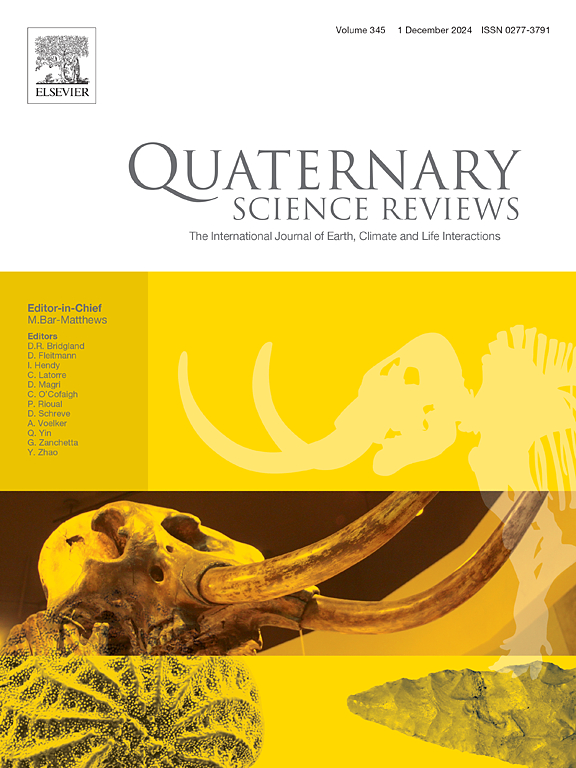New paleoecological insights for the Late Pleistocene Neanderthal mountain occurrence at Buena Pinta Cave (Iberian Central System, Pinilla-del-Valle, Madrid, Spain)
IF 3.2
1区 地球科学
Q1 GEOGRAPHY, PHYSICAL
引用次数: 0
Abstract
The Late Pleistocene sequence from the archaeological site of the Buena Pinta Cave (Pinilla del Valle, Madrid) has furnished the following ectothermic vertebrates: Salmo trutta, Alytes gr. A. obstetricans-almogavarii, Pelobates cultripes, Bufo spinosus, Epidalea calamita, Pelophylax perezi, Rana iberica, Testudines indet., Timon lepidus, Lacertidae indet. (large- and medium-sized), Anguis fragilis, Natrix maura, Coronella cf. C. austriaca, Colubridae/Psammophiidae indet., and Vipera cf. V. latastei. All these taxa are currently present in central Iberian Peninsula, with representation in the Lozoya Valley or its closest surrounding areas. The amphibians and reptiles suggest a quite similar to a much warmer climate (from +1.0 to +3.5 °C) than the present one, with a higher difference about modern values during the coldest month than during the warmest month. Annual rainfall was more abundant (from +9 to +397 mm) than today. Reconstructed landscapes suggest the predominance of humid environments throughout the sequence, primarily composed by open humid habitats (mainly comprised between 35.2 and 45.5 %) and woodland environments including medium scrublands to forest formations (27.3–40.0 %). Aquatic and peri-aquatic areas (9.5–20.5 %), such as rivers or ponds with riverside vegetation are also quite well represented, in accordance with one of the few fossil records of a water frog (P. perezi) in the Pinilla del Valle localities, and the very hypothetical occurrence of a terrapin in the Layer 2. In addition, the presence of brown trout (Salmo trutta) also supports the presence of a mature river characterized by cold/temperate and running waters. All these data suggest that the whole Late Pleistocene sequence of the Buena Pinta Cave may have occurred during a temperate to warm and humid period, more probably during the beginning of the Marine Isotope Stage 3 rather than during the end of the Marine Isotope Stage 4, as formerly suggested.
西班牙马德里Pinilla-del-Valle伊比利亚中央系统Buena Pinta洞穴晚更新世尼安德特人山地产状的古生态学新认识
来自布埃纳·平塔洞穴考古遗址的晚更新世序列(Pinilla del Valle, Madrid)提供了以下恒温脊椎动物:Salmo trutta, Alytes gr. A. almogavarii, Pelobates cultripes, Bufo spinosus, Epidalea calamita, Pelophylax perezi, Rana iberica, Testudines indet。蜱螨,蜱螨科。(大、中型)、脆弱鳗鲡(Anguis fragilis)、毛蚶(Natrix maura)、奥地利冠状蝇(Coronella cf. C. austria)、鞘翅目/沙蛉科昆虫。和Vipera cf. V. latastei。所有这些分类群目前都存在于伊比利亚半岛中部,在Lozoya山谷或其最近的周边地区有代表性。两栖动物和爬行动物表明,与现在的气候(从+1.0°C到+3.5°C)非常相似,与最冷月份相比,最暖月份的现代数值差异更大。年降雨量比现在更丰富(从+9到+397毫米)。重建的景观表明,湿润环境在整个序列中占主导地位,主要由开放湿润生境(主要占35.2% ~ 45.5%)和林地环境(27.3% ~ 40.0%)组成。根据在Pinilla del Valle地区发现的为数不多的水蛙(P. perezi)化石记录之一,以及在第2层非常假设的水龟的出现,水生和近水生区域(9.5 - 20.5%),如河边有植被的河流或池塘,也得到了很好的代表。此外,褐鳟(Salmo trutta)的存在也支持了一条成熟河流的存在,其特征是冷/温带和流动的水。这些资料表明,布埃纳平塔洞的整个晚更新世序列可能发生在温带到温暖湿润的时期,更有可能发生在海洋同位素阶段3的开始,而不是以前认为的海洋同位素阶段4的结束。
本文章由计算机程序翻译,如有差异,请以英文原文为准。
求助全文
约1分钟内获得全文
求助全文
来源期刊

Quaternary Science Reviews
地学-地球科学综合
CiteScore
7.50
自引率
15.00%
发文量
388
审稿时长
3 months
期刊介绍:
Quaternary Science Reviews caters for all aspects of Quaternary science, and includes, for example, geology, geomorphology, geography, archaeology, soil science, palaeobotany, palaeontology, palaeoclimatology and the full range of applicable dating methods. The dividing line between what constitutes the review paper and one which contains new original data is not easy to establish, so QSR also publishes papers with new data especially if these perform a review function. All the Quaternary sciences are changing rapidly and subject to re-evaluation as the pace of discovery quickens; thus the diverse but comprehensive role of Quaternary Science Reviews keeps readers abreast of the wider issues relating to new developments in the field.
 求助内容:
求助内容: 应助结果提醒方式:
应助结果提醒方式:


